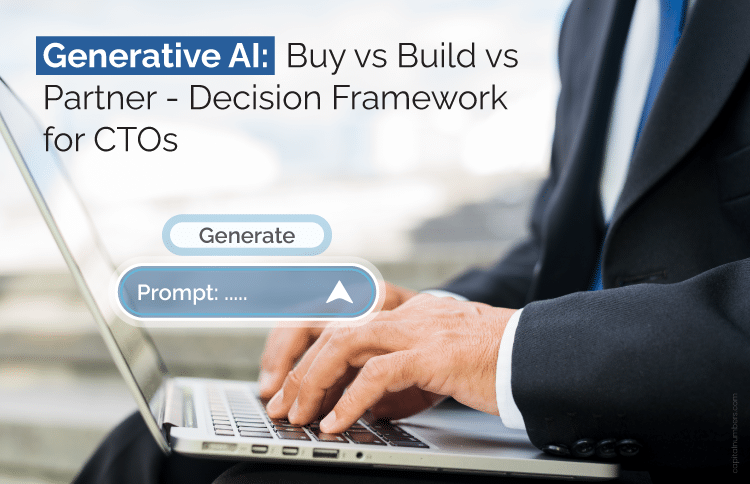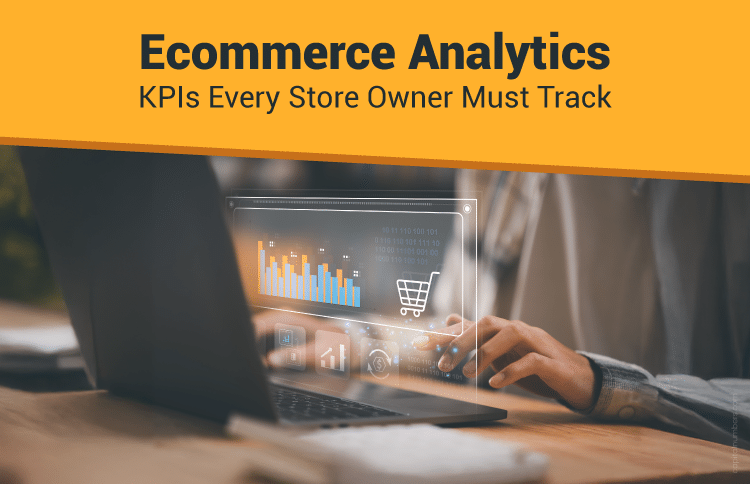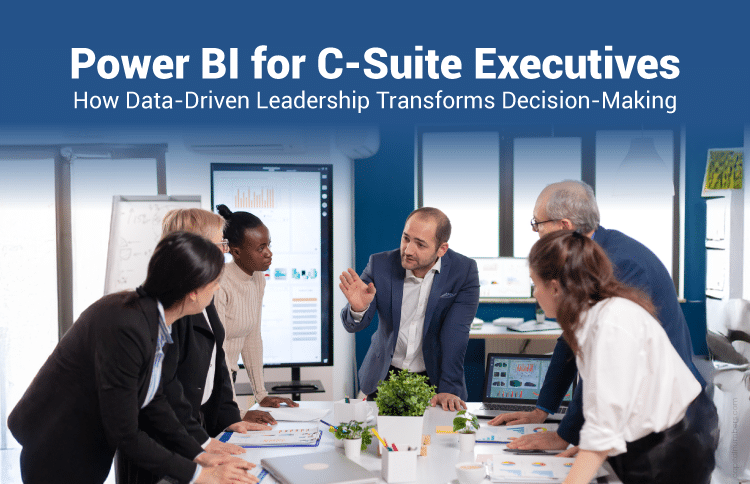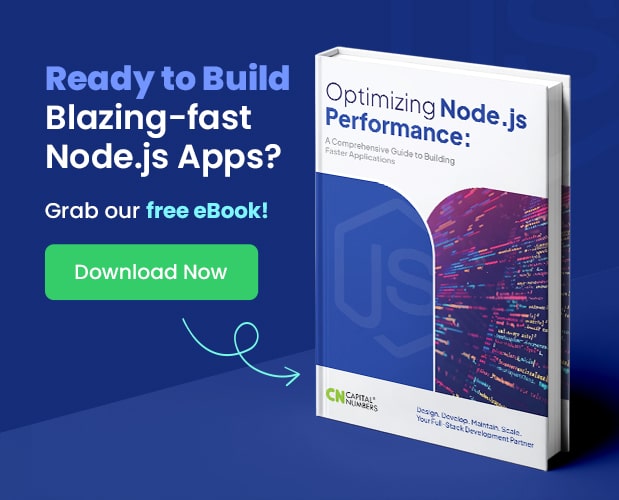Generative AI: Buy vs Build vs Partner – Decision Framework for CTOs
Table of Contents
Generative AI has moved from “cool demo” to “board-level priority” in record time. Your CEO wants AI features immediately. Your product team is pitching copilots. Your customers are starting to expect intelligent experiences by default. And in the middle of all this stands you – the CTO – trying to decide the most strategic, cost-efficient, and future-proof way to deliver it.
Do you buy an off-the-shelf GenAI solution and hit the market quickly? Do you build your own model and keep full control over data, IP, and differentiation? Or do you partner with a specialist to de-risk the journey while still shaping the outcome? Each path appears attractive on the surface – but every option comes with trade-offs in terms of time-to-value, security, talent, cost, and long-term scalability.
In this blog, we’ll use a practical framework to evaluate your options – rooted in business goals, technical maturity, and compliance needs. By the end, you’ll have a clear framework to pick the approach that delivers the fastest ROI without locking you into the wrong architecture.
Define Your Generative AI Business Objective
You should start with the business outcome, not the tool. What must generative AI change in the next 6 to 12 months – revenue growth, cost reduction, better user experience, faster product innovation, or internal efficiency? Make one goal primary and the rest supporting. This will help shape your enterprise AI strategy and guide the decision on whether to buy, build, or partner.
Map generative AI use cases to your objectives
- Content Automation (e.g., marketing, support, documentation): Increase speed and scalability while reducing costs per asset.
- Personalized Recommendations/Next Best Action: Increase revenue and boost conversion rates.
- Agent Assist/Self-Service Copilots: Improve customer satisfaction (CSAT) and reduce support costs by enabling more self-service.
- Document Intelligence (e.g., invoices, claims): Accelerate processing times while reducing operational risks.
- R&D/Product Ideation: Speed up innovation and improve product development throughput.
Generative AI Buy vs Build vs Partner: Options at a Glance
Before deciding which option is suitable for integrating generative AI for a business, the CTO should know them (buy, build, or partner) in detail. Here is a quick breakdown:
-
Buy (off-the-shelf / vendor products / APIs)
If you need results fast, buying is usually the lower-effort option. It fits when your use case is common (e.g., summarization, chat, ticket deflection) and time-to-market matters more than deep customization. Many organizations start here to validate value quickly before investing in deeper customization.
Pros:
- Rapid time-to-value, minimal setup
- Predictable pricing and support
- Easy integrations via APIs
Cons:
- Limited customization and differentiation
- Vendor lock-in and roadmap dependency
- Tighter constraints on data control
-
Build (in-house)
Choose this when you want full ownership of the stack, including data patterns and IP. If the capability is core to what makes you different and you have the engineering and data maturity, building gives you long-term control. It’s an end-to-end generative AI development shaped around your data, users, and workflows.
Pros:
- Maximum control and IP ownership
- Tailored to domain workflows
- Easier to swap models over time
Cons:
- Higher upfront cost and talent needs
- Longer path to first value
- Long-term responsibility for maintaining, scaling, and securing the solution
-
Partner (co-development with a specialist)
Go for this when you want to move faster than building alone, while keeping more control than buying. It’s the right fit when you need domain expertise or specific skills your team doesn’t yet have. It’s similar to engaging a generative AI development services provider – you co-build, move quickly, and get structured knowledge transfer so your team can own and change the solution after handover.
Pros:
- Accelerates delivery with proven patterns
- Shared risk and structured handover
- More customization than buying
Cons:
- Requires clear governance to avoid dependency
- Scope creep can raise costs
- IP and ownership must be defined upfront
In short, prioritize buying when speed is crucial, focus on building for a durable advantage, and partner to close skill gaps. This approach ensures your generative AI strategy remains practical and delivers tangible GenAI business outcomes.
Generative AI Decision Matrix: How to Choose the Right One?
Use this generative AI decision matrix to turn a messy choice into a structured one. Score each criterion 0 to 5 (0 = straightforward/commodity; 5 = high control or complexity). If your score is low, buying is likely enough; mid-range scores point to partnering; high scores suggest building. Apply the same scoring for each use case so your generative AI strategy stays consistent, explainable, and easy to defend with stakeholders.
-
Evaluation criteria (score 0 to 5 each)
- Time-to-value: How fast must you ship? (Shorter deadlines → lower score)
- Strategic differentiation: Does this create a unique advantage? (Higher = more custom)
- Cost & TCO: Is long-term cost optimization critical vs. subscription? (Higher = build bias)
- Data sensitivity & compliance: PII/IP, residency, audits? (Higher = more control)
- Talent & capability: Do you have (or want) in-house skills? (Higher = build readiness)
- Risk tolerance & vendor management: Appetite for vendor lock-in vs. ownership? (Higher = own more)
-
Scoring model (sum of 6 criteria; 0 to 30)
- 0 to 10: Buy (off-the-shelf/API).
- 11 to 20: Partner (co-development/opt for generative AI development services).
- 21 to 30: Build (in-house), because control, security, or differentiation matters most.
Adjust thresholds to fit your governance and budget.
-
Template table:
Criterion 0 to 5 Score Notes Time-to-value Strategic Differentiation Cost & TCO Data Sensitivity & Compliance Talent & Capability Risk Tolerance & Vendor Management Total -
Sample: Customer support automation (Tier-1 self-service resolution in 90 days)
- Time-to-value 1 (urgent)
- Strategic differentiation 2 (common)
- Cost & TCO 3 (scale matters)
- Data sensitivity & compliance 3 (moderate PII)
- Talent & capability 4 (some team, gaps exist)
- Risk tolerance & vendor management 4 (avoid lock-in)
Total = 17 → Partner
Interpretation: Speed up delivery, keep control, and transfer know-how so your team can run and improve it.
Practical Roadmaps for Generative AI: Buy, Build, and Partner
Use the roadmap that aligns with your enterprise AI strategy, timeline, and level of control required. Each path shows the steps, deliverables, and timelines so you can go from idea to impact with a clear plan.
-
Buy
- Vendor shortlisting: Align on the CTO’s goal and must-haves (data handling, region, integrations). Create a 5-7 vendor longlist; narrow to 2 to 3 with security questionnaires and reference calls.
- Pilot with success metrics: Define 2 to 3 KPIs (e.g., time-to-response, % resolved without an agent, accuracy vs. gold set). Limit scope to one workflow. Run A/B against baseline.
- Contract terms to watch: Data rights (no training on your data without consent), model swap/BYOM options, SLAs (Service Level Agreements) and regression remedies, audit logs, exit clauses, and pricing tiers.
- Scale plan: Playbook for rollout (enablement, change management), monitoring/evals, and a quarterly roadmap review to avoid lock-in and keep your generative AI strategy adaptable.
Deliverables (30 to 90 days): Shortlist and scorecard, pilot report with KPIs, security review, contract redlines, and scale playbook.
-
Build
- Discovery & data readiness: Confirm the outcome, data sources, governance, and risks. Close gaps in labeling, masking, and access controls.
- MVP architecture: Choose the model path (API, hosted, or private), retrieval pattern, vector store, prompt/versioning, eval harness, observability, CI/CD for generative AI development.
- Pilot: Ship a thin slice for one role/use case. Track quality, latency, and “resolved without an agent.” Capture human feedback loops.
- Productionize & governance: SLOs (Service-Level Objectives), RBAC (Role-Based Access Control), audit logs, red-teaming, and incident playbooks. Plan model swaps and cost controls (batching, caching).
- Hiring/reskilling: Platform engineer, data engineer, app dev, evaluation/QA; upskill domain teams to own prompts and workflows.
Deliverables (3 to 12 months): Architecture doc, MVP, evaluation suite, security approvals, runbooks, and hiring plan.
-
Partner
- Partner evaluation: Domain experience, reusable accelerators, references; IP stance (who owns what), security posture, commercial model (fixed/milestone vs. T&M).
- Co-development terms: Define ownership, code escrow, handover artifacts, SLAs, and milestone KPIs. Align on a steering cadence and risk register.
- Pilot: Joint team (yours + partner) ships a narrow use case fast, using their patterns while aligning to your controls.
- Handover/scale: Structured knowledge transfer, training, and playbooks so your team runs day-2 ops and iterates. Expand to adjacent workflows.
Deliverables (60 to 180 days): Partner scorecard, SoW with milestones, pilot demo, KPI report, and handover package (docs, tests, dashboards).
Across all three paths, the goal is the same: make enterprise AI decisions that are fast to prove, safe to scale, and simple to explain.
Contract and Purchasing Safeguards for Enterprise Generative AI
When engaging in generative AI development, ensure your contract includes critical clauses:
- Data ownership & usage: Clarify rights to your data and any generated models.
- Model fine-tuning rights: Ensure you can adjust and adapt models as needed.
- Security & compliance: Verify that vendors meet necessary security standards and compliance requirements.
- SLAs: Define performance expectations and penalties for non-compliance.
- Escalation & termination: Set clear procedures for issue resolution and contract exit.
- Audit rights: Retain the ability to audit the system for compliance and data usage.
Purchasing tip: Always negotiate data usage exceptions and exit/portability clauses to protect your AI investments and keep your future architecture flexible.
Governance, Risk, and Ethics in Generative AI for CTOs
Being a CTO, you should make sure that governance, risk, and ethics are integrated into your generative AI strategy from the start. Key areas include:
- Model validation: Ensure your models perform accurately and fairly.
- Red-teaming: Test for vulnerabilities and unintended outcomes.
- Human-in-the-loop: Maintain human oversight for critical decisions.
- Bias testing: Evaluate and address any biases in the model.
- Logging & provenance: Track model decisions and data usage for accountability.
- Regulatory readiness: Prepare for compliance with data protection and AI laws.
Quick Checklist for Board-level Oversight and Compliance Responsibilities:
- Review the model validation process
- Confirm red-teaming and bias testing protocols
- Ensure human oversight for critical decisions
- Implement logging and data provenance
- Stay updated on relevant regulations
KPIs to Measure Generative AI Success
To measure the success of your generative AI for business implementation, track a mix of outcome, operational, and adoption KPIs.
-
Key KPIs to Track
- Outcome KPIs: Measure business impact, such as generative AI-driven revenue uplift, cost savings, NPS/CSAT impact, and conversion lift.
- Operational KPIs: Track the performance of your generative AI systems, including MTTR (Mean Time to Resolve) for incidents, uptime, inference latency, and model drift rate.
- Adoption KPIs: Measure how widely your generative AI tools are used, such as DAU/WAU (Daily/Weekly Active Users) for internal tools, and the % of workflows automated by generative AI.
-
Suggested Structure:
- Baseline: Establish an initial benchmark for each generative AI KPI.
- Target: Define the goal for each KPI, based on business needs.
- Cadence: Decide how frequently you’ll review progress (e.g., monthly, quarterly).
This approach ensures your generative AI strategy delivers measurable impact and is continuously optimized.
Common Generative AI Pitfalls and How to Avoid Them
When implementing generative AI, CTOs often make key mistakes that can undermine success:
- Choosing tech before use-case: Selecting technology without fully understanding the problem it’s solving.
- Ignoring data readiness: Failing to assess whether the necessary data is clean, available, and compliant.
- Under-investing in MLOps: Skipping essential infrastructure for model deployment, monitoring, and scaling.
- Failing to plan the exit: Not planning for vendor lock-in or how to exit a solution when it no longer meets needs.
Remedies:
- Return to business objectives: Align technology choices with clear business goals.
- Run small experiments: Test assumptions with pilots before scaling.
- Set guardrails: Ensure compliance, security, and safety from the start.
- Budget for monitoring & maintenance: Invest in ongoing monitoring and model updates to ensure long-term success.
Conclusion: Choosing the Right Generative AI Path (Buy, Build, or Partner)
Choosing the right approach for adopting generative AI – whether to buy, build, or partner – requires careful consideration of your enterprise AI strategy and long-term goals. By evaluating the business needs, data readiness, and risk tolerance, the CTO can make an informed decision that ensures sustainable success.
Take the first step today by scoring your business priorities using our generative AI decision matrix, and reach out to us for a personalized consultation. We can help you evaluate your options and implement the right generative AI solution tailored to your business, security, and cost objectives. Contact us today!
Case Study: How We Transformed Customer Experience with AI Chatbot Development
The client, a global leader in AI-powered messaging, faced challenges with growing demand and scattered communication across platforms like WhatsApp and Facebook Messenger.
Learn how we developed a consolidated platform, incorporating AI chatbots and automated workflows to simplify processes, integrate existing tools, and improve customer service and sales. [Read the full case study here]
FAQs on Generative AI Adoption for CTOs
1. How do I ensure data privacy and compliance when using generative AI?
Ensure that the AI solution complies with data protection regulations (GDPR, CCPA, etc.). Negotiate data usage clauses, implement strong security measures, and ensure that data handling is transparent and auditable.
2. What skills and resources are needed to build generative AI in-house?
Building generative AI in-house requires a skilled team of data scientists, machine learning engineers, and domain experts. Additionally, you’ll need robust data infrastructure, training resources, and a clear understanding of the business problem you’re solving.
3. What are the costs associated with building a generative AI solution in-house?
Costs for building an in-house generative AI solution can be significant, including expenses for data infrastructure, talent (data scientists, engineers), ongoing maintenance, and model training. It’s crucial to budget for both initial and long-term costs.
4. How do I measure the ROI of generative AI investments?
Measure ROI by tracking key business metrics such as revenue growth, cost savings, efficiency improvements, or customer satisfaction. Set clear KPIs for both short-term and long-term outcomes and regularly assess performance.
5. How do I ensure my generative AI model remains accurate over time?
Regularly monitor the model’s performance, retrain it with updated data, and conduct periodic evaluations to detect and correct any model drift. Having a robust MLOps pipeline in place can help automate this process.

















